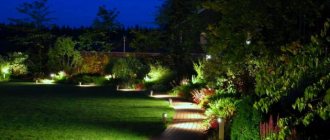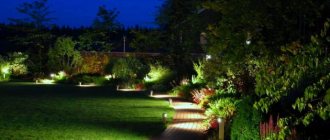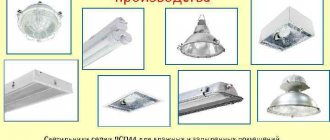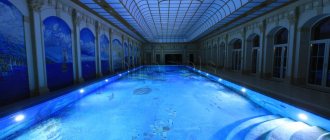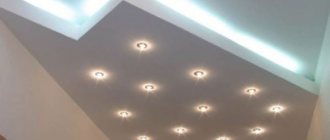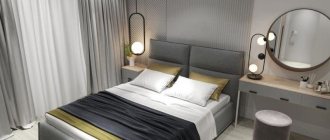Artificial lighting systems are used indoors and outdoors to complement and compensate for the lack of natural light. This ensures the continuity of active human activities, regardless of weather conditions and time of day.
They are also used in simulating controlled environmental conditions in scientific experiments, or to support the vital activity of organisms (animals, plants, bacteria) in laboratories and in production.
Types of artificial lighting. Classification
The main types of artificial lighting, distinguished by the location and purpose of the light sources:
1) General. In any type of premises (residential, office, industrial) this type of lighting requires the presence of lamps in the upper zone or on the ceiling. When organizing the overall appearance, the light should be evenly distributed throughout the entire area of the room. For a small living room, this could be a chandelier or ceiling lamp. An office or industrial space typically uses a lighting system.
2) Local. This type of lighting is designed to highlight certain areas by placing light sources directly on a designated area of the room. For local lighting of housing, the following types of lamps are used: floor, wall, pendant, tabletop, built-in. In production or office premises, special lamps are used that direct light directly to the workplace.
3) Combined. Involves the simultaneous use of general and local types of artificial lighting. Effective for all types of premises: residential, office, public and industrial.
Minimum and maximum illumination standards
The standards provide average illumination values that do not take into account the nuances of human activity in a particular room. For example, in the kitchen you usually need to illuminate the worktop and sink more brightly. Therefore, residents install additional lamps or LED strip for local illumination.
A similar situation arises for other rooms, in which the normalized level of illumination is increased in certain areas with the help of sconces, floor lamps, and table lamps. The same thing happens in industrial, administrative and public buildings. Brighter lighting is created in local areas that require it due to their specific nature. Thus, the actual illumination of workplaces does not always correspond to illumination standards.
A deviation from the standard towards the minimum of 15-20% will have virtually no effect on the visual perception of lighting. As the deviation increases, the light will appear dimmer and less comfortable.
The main types of artificial lighting, distinguished by the direction of the luminous flux:
1) Directional or direct. Involves directing a light source towards a specific surface or object. As a result of directional lighting, an object is visually enlarged by emphasizing its volume and shape. In a living room, table lamps, spotlights, built-in lamps, floor lamps with shades, etc. are used for this.
2) Indirect. This type of artificial lighting is also called reflected, as it is obtained by directing the light flux to the ceiling or walls, from which it is reflected and illuminates the room. In a living room it can be implemented using lamps with a luminous flux directed upward or onto the walls. Reflected light visually increases the area of the room and is most effective in a bright interior.
3) Diffuse lighting is obtained as a result of the passage of light through a translucent or matte lampshade and is scattered throughout the room. One ceiling lamp with diffused light can illuminate a small room.
4) Mixed. It is obtained by combining the above types of artificial lighting. A lamp with mixed lighting can distribute the luminous flux in different directions and through a translucent shade or lampshade.
Division of lighting according to purpose
Lamps are used for different purposes. Each type of lighting has its own characteristics.
street
Provides safe and comfortable movement around the locality. Flashlights with a dust and moisture protection class of at least IP65 are used.
Production premises and facilities
The following types of lighting are distinguished:
- Working.
- Emergency.
- On duty.
- Security.
The first type ensures the flow of the production process. This category includes lamps in workshops and other premises, in corridors and on transport routes of the enterprise.
Emergency lighting is powered from backup current sources and lights up in the event of an emergency shutdown of the main one.
Divided into 3 subspecies:
- Security. Prevents production process stoppages and accidents. Should provide illumination of at least 5% of normal.
- Evacuation. Illuminates the routes by which personnel urgently leave the premises. The minimum illumination in the building is 0.5 lux, outdoors - 0.2 lux.
- Signal. Indicates special areas. Used in case of fires, gas leaks, etc.
Emergency lamps are turned on during non-working hours.
Security lights are lit along the perimeter of the facility, helping to protect it from unauthorized entry.
Private and apartment buildings
In a residential property, the management company is obliged to provide lighting:
- local area: roads, parking lots, playgrounds, garbage containers;
- entrances to the entrance;
- staircases;
- elevators.
Lamps with anti-vandal devices are used outside.
Decorative lanterns are installed around a private house. The building itself, gates, paths, gazebos and other objects on the territory are illuminated.
More information about fluorescent lamps
Fluorescent lamps (hereinafter referred to as LL) differ in the spectra of radiation visible to the eye. Fluorescent lamps are close to natural light, so they are the least likely to tire your eyes. The disadvantage of this type of lamp is that their light is dominated by blue rays, which make human skin look unhealthy. White light lamps contain more yellow rays. Warm white lamps better convey pink and yellow colors, while cool white lamps emphasize the expressiveness of violet, cyan and dark blue.
LLs are sources of diffused and uniform light that does not produce a contrasting shadow. Their light output is such that, at the same power, it exceeds the similar light output of incandescent lamps. For this reason, they are economical, but under illumination conditions below 150 lux, a “twilight effect” occurs - in fact, the room is quite light, but it is not enough for the eye. If the choke is faulty, the LLs make noise or the light they emit begins to pulsate.
Incandescent lamps: pros and cons
Incandescent lamps (hereinafter referred to as incandescent lamps) have an emission spectrum with a large percentage of yellow and red colors. Purple and blue are in the minority. From the point of view of psychophysiology, their radiation is more pleasant, since it is warmer. In terms of impact on the psyche, LL clearly loses in this comparison. LN radiation is perceived by the eye as natural lighting, pleasant to the eye.
The disadvantages include extremely low energy efficiency.
The role of reinforcement in artificial intelligence
Lighting fixtures successfully combat brightness by protecting against blinding direct rays. It is divided into three types:
- fittings for direct light (directs 90 percent of the flux of light rays onto a horizontal surface, used in kitchens, hallways, bathrooms);
- fittings for reflected light (the main part of the light flux is directed to the top of the wall and ceiling, reflected from them and evenly distributed);
- fittings for diffused-uniform light (some of the rays are reflected from the walls and ceiling and scattered throughout the room, passing through frosted glass).
IO standards for residential premises assume an illumination of 50 lux in the presence of incandescent lamps, the ideal is 200. At the same time, LL indicators in a residential area are exactly twice as high as LL.
What is the standard illumination for objects for various purposes?
Streets, roads and squares
| Illuminated objects | Average illumination, Lux (not less) |
| Highways, federal and transit routes. Road class - A | |
| A1 Highways, federal and transit routes, main city highways (outside the city center) - with a throughput capacity of more than 10,000 units/hour | 30 Lux |
| A2 Other federal roads and main streets (outside the city center) - with a throughput capacity of 7,000 - 9,000 units/hour | 20 Lux |
| A3 Central highways connecting streets with access to the A1 highway (in the city center) - with a capacity of 4,000 - 7,000 units/hour | 20 Lux |
| A4 Main historical passages of the center, internal connections of the city (in the city center) - with a throughput of 3,000 - 5,000 units / hour | 20 Lux |
| Main roads and district streets. Road class - B | |
| B1 Main roads and city streets (outside the city center) - with a throughput capacity of 3,000 - 5,000 units/hour | 20 Lux |
| B2 Main roads and city streets (in the city center) - with a throughput capacity of 2,000 - 5,000 units/hour | 15 Lux |
| Local streets and roads. Road class - B | |
| B1 Transport and pedestrian connections within residential areas and access to the city on the highway, except for streets with continuous traffic - with a throughput of 1,500 - 3,000 units / hour | 15 Lux |
| B2 Transport and pedestrian connections in residential neighborhoods and access to highways (residential developments in the city center) - with a throughput capacity of 1,500 - 3,000 units/hour | 10 Lux |
| B3 Transport connections within production and utility storage areas - with a throughput capacity of 500 - 2,000 units/h | 6 Lux |
Gas stations (gas stations) and parking lots
| Illuminated objects | Average illumination, Lux (not less) |
| Gas stations | |
| Places for refueling and discharging petroleum products | 20 Lux |
| Access roads from roads of category A and B | 15 Lux |
| Access roads from category B roads | 10 Lux |
| The rest of the gas station area, which has a roadway | 10 Lux |
| Parking lots and storage areas for rolling stock | |
| Open parking on streets of all categories and neighborhoods | 6 Lux |
Pedestrian spaces
| Illuminated objects | Average illumination, Lux (not less) |
| P1 Areas in front of the entrances of cultural, sports, entertainment and shopping facilities | 20 Lux |
| P2 Main pedestrian streets of the historical part of the city and main public centers, impassable and in front of factory squares, children's, landing areas, recreation areas | 10 Lux |
| P3 Pedestrian streets, main and auxiliary entrances to parks, exhibitions, stadiums | 6 Lux |
| P4 Sidewalks separated from the roadway, main passages of microdistricts, entrances, passages and central alleys of children's and educational institutions | 4 Lux |
| P5 Secondary passages in microdistricts, utility areas, side alleys, utility entrances | 2 Lux |
| P6 Side alleys and auxiliary entrances of parks of administrative districts | 1 Lx |
Underground and overground pedestrian crossings
| Illuminated objects | Average illumination, Lux (not less) |
| Passages of underground pedestrian crossings and tunnels | 75 Lux |
| Overhead pedestrian crossing passages with transparent walls and ceiling | 75 Lux |
| Staircases, ramps and viewing platforms for elevated pedestrian crossings with transparent walls and ceilings | 50 Lx |
| Stairs and ramps of underground pedestrian crossings and tunnels | 45 Lux |
| Open footbridges | 10 Lux |
Evacuation routes
| Illuminated objects | Average illumination, Lux (not less) |
| Evacuation routes for high-risk areas | 15 Lux |
| Escape routes up to 2 meters wide | 1 Lx |
| Evacuation lighting for large areas | 0.5 Lux |
What you need to know about poor lighting
“Bad light” and “lack of light” are not always the same thing. Sometimes, when they say “bad light,” they mean flickering LL. And not everyone is aware that unevenness is far from the only characteristic of bad light. And that the worst is light that has a spectrum that is not comfortable for human vision. At the same time, its intensity does not play a role.
The optimal spectrum of light suitable for humans is the one emitted by the sun. The more similar an artificial source is to it, the better. The solar spectrum consists of different wavelengths, similar to the colors of the rainbow. In combination, they give a color called “white” according to the rules of lighting technology.
It must be taken into account that lamps have not only different power, but also color rendering and chromaticity, which are measured in units of Ra and K, respectively. LLs emit light that is closer to that of the sun than that of LNs. Each of the five phosphor bands has its own spectrum, resulting in a resemblance to the light of the sun.
To get the right lamp (and not just the most expensive one), you need to familiarize yourself with some important information. It’s reckless to just grab the least budget option and calm down. For example, specialized lamps for plants are very expensive, but they are absolutely not suitable for people.
How much light do you need to live correctly?
Lack of light not only spoils vision, but also causes fatigue. Ignorance of the basic basics regarding illumination creates inconvenience for us. The fact that our vision adapts and does not particularly feel the difference in lux, sometimes reaching a thousand units, often leads to a feeling of discomfort caused by something unknown.
A cleanly washed room is perceived as gloomy and dirty if you use a 25-watt LN. And at the same time, using a very bright LL in a dirty room, we will achieve the opposite effect.
Often in houses there are two- and three-arm chandeliers with 60–75 watts per bulb. Meanwhile, the need of the human eye is approximately 4 times higher. Many of us do not even suspect that we live in insufficient lighting, thereby harming our health.
There are official lighting standards specified in the lux for various rooms. But following them literally, firstly, is technically difficult, and secondly, it is not necessary - for several reasons:
- a difference of 100–200 lux is not perceivable by eye;
- the parameters are calculated for average vision without taking into account individuality;
- the standards are minimal due to the need to save energy.
Therefore, the norms should serve only as a guideline, and you should select an AI based on your personal needs, dividing the needs and taking into account the nuances - by trial and error. The main rule is that it is impossible to overdo it with light. This is especially true for people engaged in precision work that requires constant eye strain (jewelers, seamstresses, watchmakers). Even if you buy a lamp that is too bright in your opinion, you will not achieve a level of radiation equivalent in power to that of the sun.
How much light do you need ideally?
Light that negatively affects the retina of the eyes is considered to be of poor quality. Cost is not the main parameter in this matter, since an expensive lamp does not always mean a good one. For example, phytolamps: they are not cheap, but they are not suitable for people.
Lighting is measured in units called lux or lux. The human eye does not feel the difference between 100 lux and 200, but the body senses it. At home, there is often a lack of light, the amount of which depends on the functional purpose of the room. Based on generally accepted parameters, then bathrooms, kitchens, living rooms and wardrobes should be illuminated at 200 lux, staircases in entrances - at 150, and corridors, hallways and bedrooms - at 100. For reading, 50 is enough. Standards for a standardized room in which are constantly present, different - for example, more than 300 lux is needed for a gym, but in a warehouse it is quite possible to get by with 200. In operating rooms, the illumination level should not be less than 5000 lux, in a clinical department - at least 750 lux, and in offices - from 300 to 500.
The above standards are the minimum designed for economical electricity consumption. Not all people have enough of it under artificial lighting, and then they have to be selected individually. You should also consider how far the light sources are from the subject.
In addition to brightness, the hygienic assessment of artificial lighting should take into account other parameters, namely:
- direction of light flux;
- color gamma radiation;
- contrast and clarity of illuminated objects;
- flickering and pulsation;
- reflections and shadows.
For any of these parameters, artificial lighting may not correspond to the norm, which is guaranteed to tire not only the eyes, but also the psyche.
How to determine the required amount of light yourself
The illumination of a particular location is related to several factors. This:
- how far away is the source;
- the power of light;
- reflectivity of the ceiling, floor and walls.
A uniform distribution of light sources is in most cases optimal for achieving the effect of maximum illumination.
The level of illumination is measured with a device called a lux meter.
With its help, a hygienic assessment of natural and artificial lighting is carried out, that is, its suitability for use is measured.
Basic parameters of artificial light sources
All requirements established by law are in SNiP 23-05-95. And current information is collected in SP 52.13330.2011 “Natural and artificial lighting”. Based on these documents, optimal lighting characteristics are selected. As for the parameters, the following are considered the main ones:
- Performance indicators of the electrical network. Typically, the equipment operates on a standard voltage of 220 V, but there may be other options.
- Power of electric lamps in watts. It all depends on the type of equipment and the illuminated area.
- Illumination standards in lux. There are tables with exact data for all types of premises.
- Colorful temperature. The quality of lighting and visibility in the room or within the workplace depends on this.
- Color rendering index (Ra). Shows how correctly colors are perceived compared to sunlight. For normal perception the indicator should be 80 or more.
- Availability of additional devices. This could be a step-down transformer, ballast or light dimmer.
Determining lighting standards for office and residential premises using a table will save time.
The comfort of staying in the room or the efficiency of work depends on the quality of artificial lighting. It is necessary to select equipment that creates optimal conditions and ensures minimal strain on vision.
Important information
One of the immutable requirements for any type of artificial intelligence is safety: the presence of a grounding effect, insulation, and no access for children to a source of electricity.
The grounding effect is achieved through close contact of a conductive object with the soil. There are natural and artificial ground electrodes: the first are created by nature (trees), the second by man (lightning rod, rubber). In conditions of thunderstorms accompanied by lightning, artificial grounding has more than once saved people from electrical injuries.
AIs are indispensable for creating selfies, which have recently become a trendy trend. It is possible to create a high-quality selfie in natural light, but it is technically more difficult - you need to take into account where the sun is so that your face is not backlit, which is unacceptable for a selfie. AI allows you to control and adjust the level of illumination, so taking selfies in artificial light is much easier. This phenomenon is so popular in our time that it is possible that in the near future the hygienic requirements for artificial lighting will include suitability for high-quality selfies.
It is impossible to completely abandon natural light. But getting by with just one is also unrealistic for a modern person. Finding the optimal balance of natural and artificial lighting in the premises will create a comfortable environment at home, conducive to productive work, a mood at work and a favorable atmosphere for relaxation in places of entertainment.
Lighting and occupational health
The human eye is capable of perceiving light waves with a length of 380–760 nanometers. Staying for a long time without light reduces a person’s metabolic rate, leads to visual impairment, increases fatigue, and leads to injuries in the workplace. Monochrome light with a poor spectral composition causes similar reactions. Too bright electric lighting also leads to negative consequences. The nervous system becomes overexcited, visual characteristics decrease, and diseases such as cataracts, eye burns and others appear. To ensure worker safety, industrial lighting is regulated.
To determine light intensity in sanitary and hygienic standards, the illumination index (E) is used. To calculate it, the following lighting technical units are used: luminous flux (F) and surface area (S). Thus, the illumination indicator is determined by the formula:
E = F / S
It is measured in lux (lx) by special devices - lux meters.
The documents provide illumination standards that depend on the accuracy of the work performed.
Based on the size of the smallest discernible object, 8 visual groups are distinguished. Limits for natural and artificial light have been established for each group. Compliance with hygienic requirements for industrial lighting is checked at the point of minimum illumination on the working surface. SNiP 23-05-95 standards are used in the design and construction of industrial buildings and premises, and agricultural enterprises. Also worth mentioning is SanPiN 2.2.1/2.1.1.1278-03, which regulates lighting standards for public buildings and residential premises.
